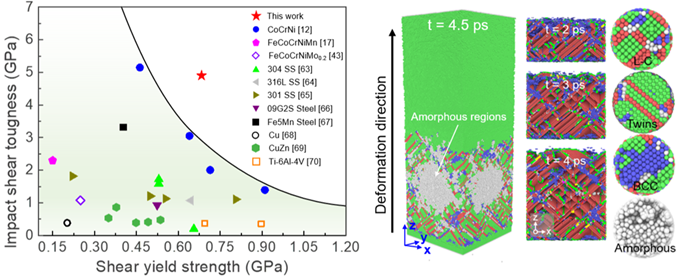Nanoprecipitates helps alloy achieves high-impact resistance
Published 19 May, 2025
3d transition metal high-entropy alloys have attracted much attention as a fire-new materials over the past two decades due to their exceptional damage tolerance over a wide temperature range. However, their practical applications are severely limited by their relatively low impact strength.
In a new study published in Advanced Power Materials, an international team comprising researchers from Central South University, Hunan University, Beijing Institute of Technology, City University of Hong Kong, and University of California San Diego reported an advanced impact-resistant nano-precipitation-strengthened high-entropy alloys. These novel alloys achieved ultrahigh gigapascals yield strength under quasi-static to dynamic loading conditions and superb resistance to adiabatic shear failure.
“Nanoprecipitates shows multiple functions under dynamic impact; not only as dislocation barrier and dislocation transmission medium that bring ultrahigh strength, but also as energy-absorbing islands that disperse the strain energy through order-to-disorder transition," says lead author Ao Fu.
"In addition to dislocation slipping and microbanding that often occur in quasi-static conditions, high-density twinning, phase transition, and amorphization are activated during dynamic deformation process, providing multiple pathways to relieve stress concentration," co-author Zezhou Li adds.
To understand the microstructural evolution, the team integrated experimental characterization with molecular dynamics simulations for obtaining a multiscale perspective to elucidate the underlying mechanisms of superior impact resistance.
"The introduction of high-density nanoprecipitates generates high local stress field, thereby enabling synergistic activation of multiple deformation mechanisms," explains co-author Jia Li.
"We believe that this alloy design strategy of introducing nanoprecipitates into high entropy alloys can greatly improve the development of impact-resistant structural materials," concludes corresponding author Bin Liu.

Contact author details: Bin Liu, State Key Laboratory of Powder Metallurgy, Central South University, Changsha, China, binliu@csu.edu.cn
Funder: This research was grateful for the financial support from National Natural Science Foundation of China (Grant No. 52020105013 and 52401223), Natural Science Foundation of Hunan Province (Grant No. 2022JJ20001), Science and Technology Foundation Strengthening Program (Grant No. 6142902210104), and Hong Kong Special Administrative Region of China (Grant No. C1020-21G).
Conflict of interest: The authors declare that they have no known competing financial interests or personal relationships that could have appeared to influence the work reported in this paper.
See the article: Fu, A., et al., Superb impact resistance of nano-precipitation-strengthened high-entropy alloys, Advanced Powder Materials, Volume 4, Issue 2, 2025, Pages 100277, https://doi.org/10.1016/j.apmate.2025.100277.